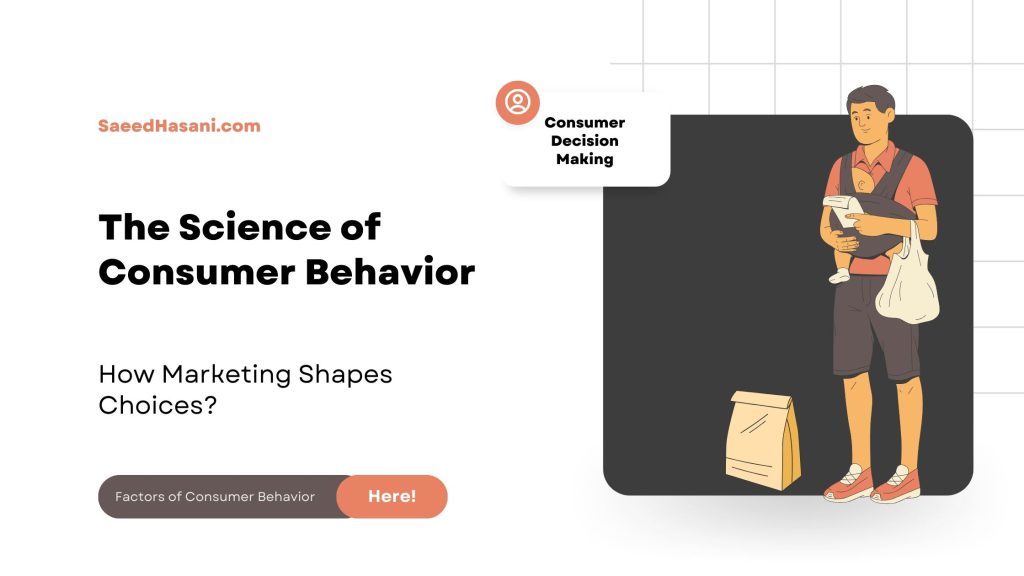The Science of Consumer Behavior: How Marketing Shapes Choices

Consumer behavior is a multifaceted and dynamic field that explores the complex interplay of psychological, social, and cultural influences on individuals’ decision-making processes.
In today’s ever-evolving marketplace, understanding the intricacies of consumer behavior is not only a competitive advantage but a strategic imperative for businesses. From the psychological triggers that drive consumer choices to the powerful sway of social networks and cultural values, this comprehensive overview delves into the myriad factors that shape the decisions consumers make.
This exploration highlights the pivotal role consumer behavior plays in crafting effective marketing strategies, building lasting customer relationships, and ultimately achieving sustainable success in a constantly changing business landscape.
Understanding Consumer Behavior
Understanding consumer behavior is essential for businesses aiming to thrive in today’s dynamic marketplace. It involves delving into the complex web of factors that influence individuals’ purchasing decisions.
From psychological triggers and emotional responses to social, cultural, and economic influences, a comprehensive understanding of consumer behavior can empower companies to tailor their products, services, and marketing strategies effectively.
In an age of information overload and ever-evolving consumer preferences, staying attuned to the subtle nuances of consumer behavior is not merely a competitive advantage but a strategic imperative.
By deciphering the motivations and desires that drive consumers, businesses can build lasting relationships, enhance customer satisfaction, and ultimately achieve sustainable success in a constantly changing business landscape.
Defining consumer behavior and its significance
Consumer behavior, at its core, is the study of how individuals or groups of people make decisions regarding the purchase, use, and disposal of goods, services, or ideas. It encompasses a wide array of factors, including psychological, social, cultural, and economic influences, all of which shape consumer choices.
Understanding consumer behavior is of paramount significance for businesses and marketers as it provides invaluable insights into what drives people to buy, what influences their preferences, and how they respond to various marketing strategies.
By deciphering consumer behavior, companies can tailor their products, pricing, promotion, and distribution strategies to align more effectively with their target audience’s needs and desires.
That not only leads to increased sales and customer satisfaction but also allows for the creation of more sustainable and long-lasting customer relationships, ensuring a competitive edge in today’s dynamic and competitive marketplace.
The psychological aspects of consumer decision-making
The psychological aspects of consumer decision-making play a central role in shaping the choices individuals make when selecting products or services. These aspects delve into the intricate workings of the human mind, exploring factors such as perception, motivation, attitudes, and emotions.
Perception influences how consumers interpret information from their environment, affecting their product evaluations. Motivation drives consumers towards fulfilling their needs and desires, guiding their purchase decisions.
Attitudes are shaped by past experiences and beliefs, impacting how consumers perceive brands and products. Emotions, on the other hand, can strongly influence decision-making, often leading to impulsive choices.
Understanding these psychological aspects is crucial for businesses as it allows them to craft marketing strategies that resonate with consumers on a deeper level, thereby increasing the likelihood of successful product adoption and brand loyalty.
The Role of consumer behavior in shaping marketing strategies
Consumer behavior plays a pivotal role in shaping marketing strategies as it provides the foundational insights necessary for businesses to reach and engage their target audiences effectively.
By understanding the preferences, motivations, and purchasing patterns of consumers, marketers can tailor their product offerings, pricing strategies, promotional campaigns, and distribution channels to align with the needs and desires of their customers.
Consumer behavior data helps companies identify market segments, refine their messaging, and create compelling value propositions. In addition, it allows businesses to predict trends. Also, respond correctly to customer preferences that are constantly changing and stay ahead of competitors.
Ultimately, the successful integration of consumer behavior insights into marketing strategies not only enhances customer satisfaction but also drives revenue growth, fosters brand loyalty, and ensures long-term business success in a competitive marketplace.
Factors That Influence Consumer Behavior
Consumer behavior is shaped by a multitude of factors, ranging from individual to external influences. On an individual level, psychological factors such as perception, motivation, attitudes, and learning significantly impact how consumers make choices.
Social influences, including family, peer groups, and culture, play a vital role in shaping preferences and purchase decisions. Economic factors, such as income and pricing, directly affect a consumer’s ability to buy and the choices they make.
Additionally, situational factors like the immediate environment and context of a purchase, as well as marketing stimuli like advertising and product placement, can sway consumer behavior. Technological advancements and digital platforms have also become increasingly influential in recent years.
A profound comprehension of these varied elements is indispensable for businesses aiming to formulate successful marketing strategies that connect with their specific audience and adjust to the constantly changing terrain of consumer behavior.
Psychological Factors
Psychological factors are a crucial component of consumer behavior, encompassing the intricate workings of the human mind that influence purchasing decisions. These factors include perception, motivation, attitudes, and learning.
Perception dictates how consumers interpret and make sense of the information they receive from the world around them, affecting their product evaluations and choices.
Motivation, driven by needs, desires, and goals, acts as the engine behind consumer decision-making, compelling individuals to seek out products or services that fulfill those motivations.
Attitudes, molded by prior experiences, convictions, and emotions, wield substantial influence over consumers’ perceptions and reactions to brands and products.
Learning, both through direct experiences and exposure to marketing messages, also molds consumer behavior by influencing preferences and purchase decisions.
Understanding these psychological factors is pivotal for businesses as it allows them to design marketing strategies that effectively tap into consumers’ mental processes and create a more compelling and persuasive brand experience.
Perception and its impact on consumer choices
Perception is a fundamental psychological factor that profoundly influences consumer choices. It refers to the way individuals interpret and make sense of information from their environment, including how they perceive and evaluate products, brands, and marketing messages.
Consumers’ perceptions are shaped by sensory cues, such as sight, sound, taste, touch, and smell, and are filtered through their past experiences, beliefs, and cultural influences. These perceptual processes have a significant impact on purchasing choices, as consumers often prefer products and brands that are similar to their needs, values, and desires.
Therefore, businesses strive to manage and influence consumer perceptions through strategic product design, branding, advertising, and packaging to ensure that their offerings are perceived favorably and stand out in the competitive marketplace. Understanding the nuances of perception is essential for marketers aiming to create products and experiences that resonate with their target audience.
Motivation and the hierarchy of needs
Motivation, as described by Abraham Maslow’s Hierarchy of Needs, is a foundational psychological concept that profoundly influences consumer behavior. When we examine Maslow’s theory, we find that a hierarchy of needs drives people.
This hierarchy of needs includes physiological needs (such as food and shelter), safety needs (such as financial security), social needs (such as belonging and connection), esteem needs (such as recognition and success), and self-actualization needs (realization of one’s potential).
In the context of consumer choices, understanding this hierarchy is crucial because it helps marketers tailor their products and marketing strategies to address consumers’ specific motivational needs. For example, advertising may emphasize how a product fulfills safety or social needs, ultimately motivating consumers to make a purchase.
By aligning their products and services with these fundamental human motivations, businesses can craft marketing campaigns that are not only more compelling and persuasive but also resonate with consumers on a profound level.
Learning and memory in consumer decision-making
Learning and memory are integral aspects of consumer decision-making, shaping how individuals evaluate and choose products or services. Learning occurs through direct experiences with products or exposure to marketing messages.
These experiences create associations and expectations in consumers’ minds, influencing their future choices. Positive experiences lead to brand loyalty and repeat purchases, while negative ones can deter consumers. Memory assumes a pivotal role in this process by storing information pertaining to products, brands, and previous experiences.
Marketers strive to enhance brand recall and recognition through various strategies, including catchy slogans and memorable advertising campaigns. Understanding the interplay between learning and memory is vital for businesses, as it allows them to create effective marketing strategies that capitalize on consumers’ ability to recall and recognize their brand and products, fostering long-term customer relationships and driving sales.
Social Factors of Consumer Behavior
Social factors are:
- A significant influence on consumer behavior.
- Reflecting the impact of society.
- Culture.
- Interpersonal relationships on individuals’ choices.
These factors encompass family, peer groups, social norms, and cultural values. Family often serves as a primary source of influence, shaping consumer preferences and purchase decisions through shared values, traditions, and financial considerations.
Peer groups can exert pressure and influence over product choices, particularly among younger demographics. Social norms, which define acceptable behavior within a given society, can dictate what products or brands are considered desirable or appropriate.
Additionally, cultural values and beliefs play a substantial role in shaping consumer preferences, as they influence perceptions of quality, prestige, and relevance. Businesses must recognize the significance of these social factors and adapt their marketing strategies to align with the values and norms of their target audiences, ultimately fostering stronger connections with consumers and driving brand loyalty.
The influence of family and social networks
The influence of family and social networks on consumer behavior is profound and far-reaching. Families often serve as the nucleus of consumer decision-making, impacting everything from what products are purchased to where and how they are bought.
Family members influence one another through shared values, traditions, and financial considerations, making them crucial players in shaping individual preferences. Beyond the family, social networks, including friends, colleagues, and online communities, play an increasingly significant role.
Recommendations and endorsements from trusted connections can sway consumer choices, leading to a ripple effect of influence within these networks. In the digital age, social media platforms amplify this impact as individuals seek and share opinions, reviews, and recommendations with their social circles.
Understanding and harnessing the power of family and social networks in consumer behavior is vital for businesses looking to craft effective marketing strategies and build brand loyalty by tapping into the interconnected web of influence that surrounds each consumer.
The power of reference groups and social norms
The power of reference groups and social norms in consumer behavior cannot be underestimated. Reference groups are the people or social groups to which individuals compare themselves and seek approval. These groups can include friends, colleagues, or even celebrities and influencers.
Consumers often look to reference groups for guidance on what products to buy or behaviors to adopt as they seek to conform to the norms and values of these influential groups. Social norms, on the other hand, are the unwritten rules and expectations that define acceptable behavior within a given society or group.
These norms shape consumers’ perceptions of what is “normal” or “appropriate,” influencing their product choices and consumption patterns. Marketers leverage these dynamics by showcasing products or brands as aligning with the values and lifestyles of specific reference groups or by highlighting how their offerings conform to prevailing social norms.
By comprehending and skillfully harnessing the influence of reference groups and social norms, businesses can formulate marketing strategies that deeply connect with consumers, eliciting emotional responses and thereby fostering brand preference and loyalty.
Cultural and subcultural influences on consumer behavior
Cultural and subcultural influences exert a significant impact on consumer behavior, reflecting the profound role of society’s shared values, beliefs, and customs. Culture encompasses the broader set of values, norms, and traditions that characterize a society, influencing consumers’ fundamental attitudes and preferences.
Subcultures, on the other hand, represent smaller groups within a society that have their distinct cultural characteristics, such as ethnic, religious, or regional subcultures. These cultural and subcultural factors shape consumers’ perceptions of what is desirable, appropriate, and meaningful in terms of products and brands.
For instance, different cultures may prioritize different features or qualities in products, affecting consumers’ buying decisions. Subcultures can further diversify these preferences, leading to unique consumer behaviors within each subgroup.
Businesses that recognize and respect these cultural and subcultural influences can tailor their marketing strategies to resonate with specific audiences, thereby enhancing their brand’s relevance and appeal to a diverse and multicultural customer base.
Conclusion
In conclusion, the science of consumer behavior is a dynamic and multifaceted field that holds the key to a business’s success in today’s ever-evolving marketplace. This thorough investigation has illuminated the complex interplay of psychological, social, and cultural elements that mold the decision-making processes of individuals.
Understanding consumer behavior is not just a competitive advantage; it is a strategic imperative for businesses looking to thrive. From the subtle nuances of perception to the profound influence of social networks and cultural values, this knowledge empowers companies to craft effective marketing strategies, build lasting customer relationships, and navigate the complexities of the modern business landscape.
By deciphering the motivations and desires that drive consumers, businesses can forge a path toward sustainable success, where customer satisfaction and brand loyalty reign supreme. In this dynamic and competitive marketplace, consumer behavior remains a compass guiding businesses toward a prosperous future.







Responses